|
Herreshoff
Manufacturing Company in World War Two
Bristol, RI
1863-1945
This page updated 2-28-2025.
An American Auto Industry in World War Two Special Edition
This is the story of one small boat
manufacturer in Bristol, RI. It could be the story of dozens of
companies that produced small wooden and steel ships for the war effort.
Herreshoff produced seven different types of small boats for the war
effort. At the end of the war, it had built 100 of them.
Adding these 100 to the small number of boats built at each shipyard
along the ocean coasts and Great Lakes added up to the huge number
required to fight a war that relied on shipping of men and material
across the vast oceans of the world.
Herreshoff went out of business on January 8,
1945, when it completed Army Rescue Boat P-661. It was the last of
many boats and yachts the company built since 1863. The company
had been struggling at the end of the 1930s and was about to close when
orders started to flow in for the war effort. The 100 ships that
Herreshoff built from 1941-1945 kept the company on life support until
the contracts ceased at the end of 1944. Management realized that
the company would be unable to start building yachts or other civilian
vessels until the war was over. Even if it could have started back
into building yachts, there was limited labor and material available.
Therefore, management announced to the employees on November 28, 1944,
that the company was ceasing operations. The 100 ships of the Herreshoff
contracts kept 2,000 workers employed for four years of the war.
This should have been the end of the story,
and the company name and its accomplishments of 82 years lost forever.
But in 1971, a museum was started in Bristol, RI by the grandson of the
original Herreshoff brothers when HMco boat number 248, built in 1905,
was donated by its owner for a museum. Today that boat, the "Thania,"
is on display among an excellent collection of other Herreshoff-built
boats at the Herreshoff Marine Museum at 1 Burnside Street in Bristol,
RI. The company had many of its buildings on Burnside Street when
it was in business. Also, the museum has a complete history of the
Herreshoff family and the many great boats and yachts it made. For
once, an American company's important history was not lost to the ages.
I highly recommend this museum to anyone with an interest in boating or
the history of a company that made first-class yachts.

The company originally started 1863 when
J.B. Herreshoff and Dexter Stone formed a partnership to build boats.
In this 1866 photo, Charles Herreshoff, the father of J.B., is on the left.
He assisted his sons in their interest in building boats. Next
from the left is J.B. Herreshoff and then Dexter Stone. To the far
right is James Herreshoff. For the next fifteen years, J.B. built
boats while his younger brother Nat went to the engineering school at
MIT. In his spare time, Nat designed boats and sent the designs to
J.B. to build. After graduating from MIT, Nat went to work for a
company making steam engines in order to understand the power plant for
boats of the era. In 1878 the two brothers formerly got together
and formed the Herreshoff Manufacturing Company. Nat would go on
to design five America's Cup winners which the company built. The
company became known for its fast boats.
This website is divided into five sections.
Part One has photos of the Herreshoff complex at the time of World War
Two and a diorama of the Burnside Street complex that is on display at
the Herreshoff Marine Museum. Part Two details the company's
contribution to the winning of World War Two. Part Three has
photos of the company's records showing the 100 ships it built during
the war. Part Four is the booklet the company published and
distributed to its 2,000 employees to document the company's
accomplishments during the war. Part Five has photos of several of
the pristine boats from the collection the museum has on display.
Part One:

This photo shows the boat houses, the
several manufacturing plants, and warehouses on Burnside Street.
The south yard of the Herreshoff complex is in the upper right of the
photo. This photo is looking to the south.

This photo is looking northeast and shows
the boathouse and the buildings on Burnside Street. The Herreshoff
Marine Museum is located in the wooded area on Burnside Street. It
was a park at the time of the photo. The original south boathouse
was destroyed in a hurricane in 1937. This November 1944 photo
shows the new south boathouse and what the complex looked like just
before it closed in January 1945. There are two 63-foot Army
rescue boats docked at the pier.

This is the current view of where the two
boathouses were located. Author's photo.
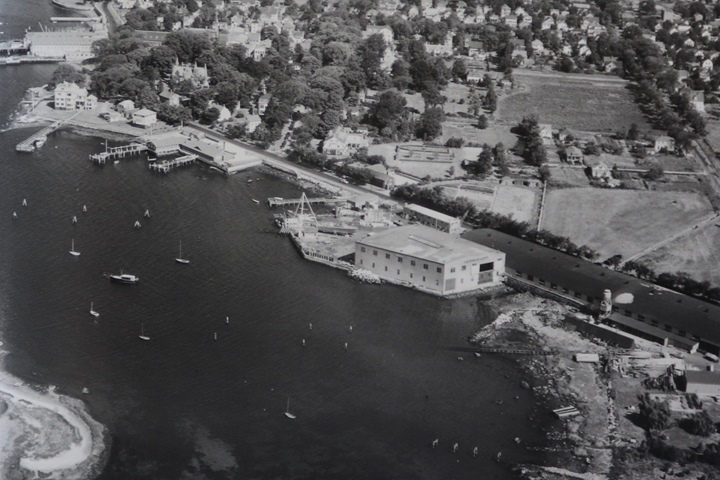
This is the south yard. It is also all
gone. Today there are houses where boats used to be built.

This is called the Burnside building which
was used as a warehouse by the Herreshoff Manufacturing Company.
It is the only company-operated building that is still in existence.
The museum has a fund-raising campaign in progress to restore the
building. Author's photo.

This is a display of the Herreshoff Burnside
Street complex as it was in 1914. Each building is numbered as to
what its function was. Author's photo.

This is the east end of the complex.
Building 16 was the paint shop. Number 17 was the foundry.
Building 14 was the boiler assembly plant for the steam engines that
were installed in many of the boats. Buildings 12 and 13 contained the
machine shop. Building 9 was the new storehouse that was built in
1917. Author's photo.

Building 8 was the east construction shop
for final assembly of medium sized boats. Building 21 is the
Herreshoff Homestead which still exists and is owned by the museum.
The park is the location of the museum. Author's photo.

This shows the north and south boat house.
Building 19 is central steam plant. Author's photo.

Author's photo.

Building wooden boats included more than
just cutting wood. The Herreshoff Manufacturing Company in 1914
manufactured all of the components that went into making a boat.
It was what was later called a vertically integrated company.
Author's photo.
Part Two: Herreshoff Manufacturing
Company World War Two Products - Table
1 shows that the company had $9,540,000 in major contracts during World
War Two. The contracts were for 2 130-foot YMS boats, 28
71-foot Vosper PT boats, 4 97-foot AMcs, 22 103-foot APcs, 8 85-foot
Army Rescue boats, and 36 63-foot Army/Navy Rescue boats.
Table 1 - Herreshoff
Manufacturing
Company's Major
World War Two Contracts
The information below comes from the "Alphabetical Listing
of Major War Supply Contracts, June 1940 through September
1945." This was published by the Civilian Production
Administration, Industrial Statistics Division, Requirements
and Progress Branch January 21, 1946. |
|
Product - Customer |
Contract Number |
Contract Amount |
Award Date |
Completion
Date |
| Minesweepers
- Navy |
NOS-80021 |
$304,000 |
1-1941 |
6-1941 |
| Minesweepers
- Navy |
NOS-83448 |
$268,000 |
3-1941 |
11-1941 |
| Mine Sweepers
- Navy |
NOS-83470 |
$680,000 |
3-1941 |
6-1942 |
| Vessels -
Navy |
NOS-94639 |
$696,000 |
11-1941 |
10-1942 |
| Craft Small -
Navy |
OBS-565 |
$1,430,000 |
4-1942 |
3-1943 |
| Vessels
Transport - Navy |
OBS-771 |
$1,751,000 |
9-1942 |
4-1943 |
| Submarine
Chasers - Navy |
OBS-1060 |
$2,066,000 |
5-1943 |
5-1944 |
| Aircraft
Rescue Boats - Army Transportation Corps |
TC-781 |
$782,000 |
11-1943 |
4-1944 |
| Aircraft
Rescue Boats - Army Transportation Corps |
TC-1420 |
$501,000 |
2-1944 |
6-1944 |
| Aircraft
Rescue Boats - Army Transportation Corps |
TC-1421 |
$501,000 |
2-1944 |
7-1944 |
| Aircraft
Rescue Boats - Army Transportation Corps |
TC-1422 |
$501,000 |
2-1944 |
8-1944 |
| Engineering
Services - USAAF |
AC-10411 |
$60,000 |
4-1945 |
7-1945 |
| Total |
|
$9,540,000 |
|
|

This poster, detailing the types of ships built
by Herreshoff during World War Two, is located in a window of the
museum. It lists the names of the 2,000 workers who built the 100
ships. I have never before seen a company that publicly listed all
its World War Two employees. Author's photo.

The Haffenreffer Family owned Herreshoff
during World War Two. Author's photo.

Author's photo.

AMc-50 is shown on sea trials. This
was the first ship that the Herreshoff Manufacturing Company built for
the war effort. Construction started on it on December 20, 1940. It was
delivered on June 2,1941. It cost $152,000 to build and was named
the "Marboot." There were three more AMc 97-foot minesweepers
built by Herreshoff. Each of them had a name. These were the
only four ships of the 100 that the company built that were named.

The company then built two YMS 136-foot
minesweepers. YMS-19 was the second one and was completed on May
9, 1942. YMS-19 was one of thirteen YMS class minesweepers to be
sunk by a mine during World War Two. It went down on September
24,1944 in the area of the Palau Islands in the Pacific Ocean.
Minesweeping was hazardous duty.

Herreshoff-built APc-86 undergoing sea
trials on May 5,1943. Twenty-two were built between October 1942
and July 1943. They were 103-feet long and of all wooden
construction. The APc class boats were used by the Navy as
coastal transports. Herreshoff built APc-1 to APc-10 and APc-85 to
Apc-96. They were powered by Superior 400hp diesel engines.
The cost of APc-1 to APc-10 was $145,000. The cost of the second
series of APc-85 to Apc-96 went up a little bit. They cost
$145,950.

APc construction was moved outdoors
to Walker's Cove which is a quarter of a mile south of where the museum
is today. There are three APcs under construction in this August
19, 1942, photo. They are APc-3,4 and 5. The first APc order that Herreshoff
received from the U.S. Navy was in June 1942.

Herreshoff built twenty-eight 71-foot Vosper
PT boats during the war. This was done under two different orders,
the first of which the boats were given British Motor Torpedo Boat
numbers. BPT-29 to BPT-36 were delivered between March 18, 1943, to
July 9, 1943. Each one cost $87,000. The second group of 20
were given U.S. Navy PT boat numbers PT-430 to PT-449 and were delivered
between February 28, 1944, to May 26, 1944. These cost $103,299
each. Above is PT-434 getting fitted out at the Herreshoff yards
and was delivered on March 12, 1944. PT-435 can be seen behind
PT-434 with another unidentified PT next to it and behind it. The
71-foot Vospers were powered by three Packard 4M2500 engines.
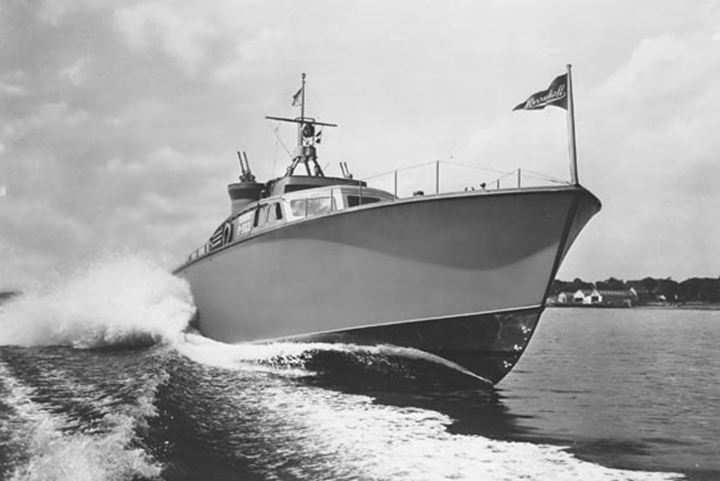
P-563 during sea trials. The
Herreshoff boat houses can be seen in the background. Herreshoff
delivered eight 85-foot rescue boats between July 5 and September 1,
1944. These were delivered to the U.S. Army as P-560 to P-567.
The 85-foot boats were powered by two Packard 4M2500 1,500 hp gasoline
engines. The cost of each boat was $97,780.

This engineering drawing gives two views of
the 85-foot rescue boat. Note that the two Packard 4M2500 engines
face forward and the power is directed to the rear via a transfer case.
Drawing added 1-25-2020.

Four 63-foot rescue boats are being built on
an outside production line at the Herreshoff South Yard. A crane
is installing a Hall-Scott 630 hp V-12 "Defender" gasoline engine.
Each 63-rescue boat was powered by two of the engines. Herreshoff
delivered 36 of the 63-foot rescue boats between August 1, 1944 and
January 8, 1945. This was a delivery rate of more than one per week.
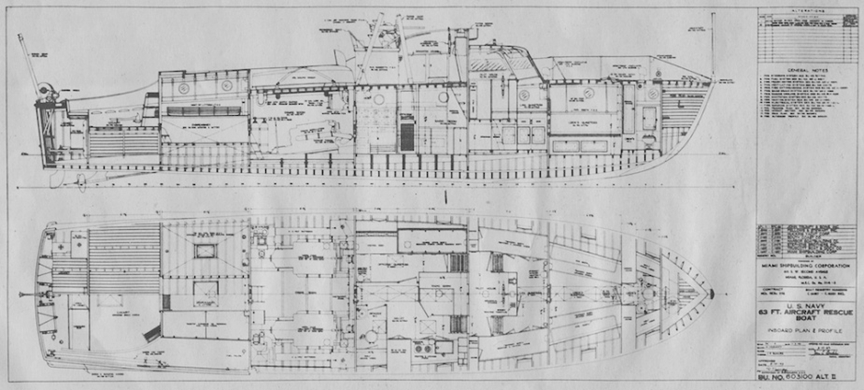
Here is an engineering drawing showing the
outline of the 63-foot Aircraft Rescue Boat. Drawing added
1-25-2020.

This drawing shows the top view of the 63-foot
rescue boat. Drawing added 1-25-2020.

This 63-foot rescue boat is undergoing sea
trials off the coast of Rhode Island before delivery to the Army.
"U.S. Army" is painted on the side of the bridge of the boat. It
appears to be number 639 which was completed on September 21, 1944.
The cost of each boat was $41,750.

The last Herreshoff ship ever built!
This is P-661, a 63-foot Army rescue boat. There is a trailer
pulled up in front of the bow of the boat for the launching ceremony of
the last boat built by a company that started building small watercraft
in Bristol in 1863. By the time of this photo, most of the 2,000
wartime employees had already been let go. The only employees
remaining were those needed to finish the last rescue boats and shut
down the facility. This must have been a bittersweet moment for
those involved in the launching of this boat.
Part Three: Below are the
Herreshoff Manufacturing Company's records from the World War Two era.
In visiting the Herreshoff Marine Museum in June 2019, I was pleasantly
surprised to find that the Museum had these records, and that I was able
to photograph them. What a treasure trove of information the
documents below provide! In most cases, even the cost of the ships
is included. This is the first time I have ever come across a
company's hand written records of the products it built to win World War
Two. The records have also provided information on the Hall-Scott
company, verifying that its 620hp "Defender" engines were used in Army
63-foot rescue boats.
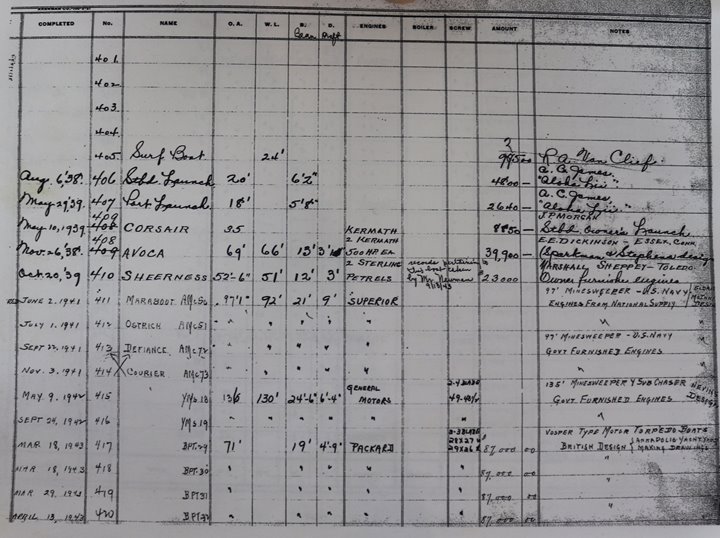
This page shows the company completed its
first 97-foot AMc minesweeper on June 2, 1941. Note that the boats
were built by group. This allowed the company and workers to cut
and fabricate the wood for only one type of boat at a time, speeding up
production and keeping costs low.

Note the increase in cost from APc-10 to
APc-85 of $900 per unit.


The entry for P-626 shows that 63-foot Army
rescue boats were powered by two Hall-Scott 630hp engines, which is evidence of
their use in this type of boat. Information on applications of the
Hall-Scott engines is sparse. This entry is important for those
researching Hall-Scott during World War Two.

Handwritten notes along the left edge of
this page show that some 63-foot rescue boats went to the Navy and the
Coast Guard.

The end of the line for the Herreshoff
Manufacturing Company.
Part Four: 100 Fighting Ships built
during World War Two by Herreshoff - In 1944 it was announced that
Herreshoff would close with the end of its war contracts. The
company printed 2,000 copies of the booklet below and gave them to the
employees to show what they had accomplished during the war. Of
the 2,000 that were printed, only one is still known to exist, and is in
the library at the Roger Williams University in Bristol, RI. It is
not allowed out of the library for inter-library loan, like other World
War Two company histories, because it is so rare. I therefore
visited the library in person in June 2019. The library staff was
most helpful in allowing me to read and photograph this rare, and maybe
one-of-a-kind document.




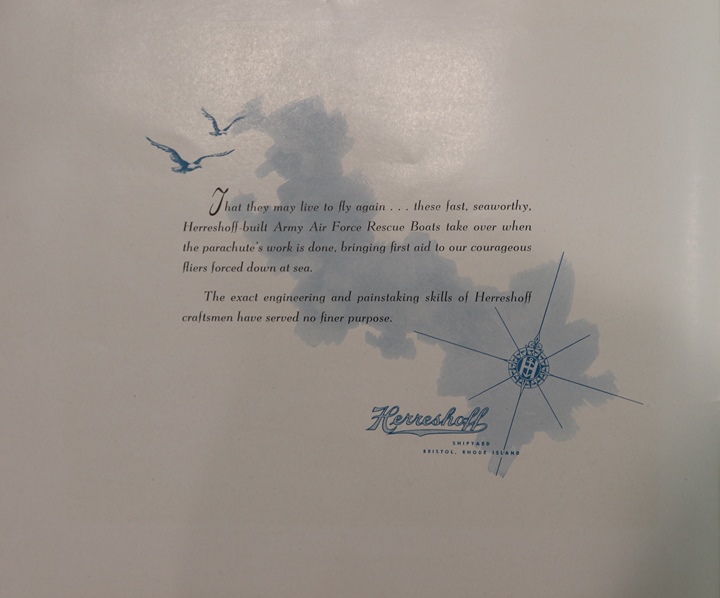













Part Five: The Herreshoff Marine
Museum - I am still amazed that such a museum exists for a
company that has been gone for so long. But I think it attests to
the importance Herreshoff had to the community in providing jobs, and
the quality of the boats and ships they made. One does not need to
be a boating or sailing enthusiast to recognize the quality and
workmanship of the products the company built during its existence.
I recommend a stop at the Herreshoff Marine Museum for anyone traveling
in the area.

The Herreshoff Marine Museum. The
building is very functional and the space inside is well utilized for
historical displays and ships. The entrance is under the blue
awning and is where the displays on the history of the company are
located. Behind the overhead door are the examples of the boats
and ships the company built. Author's photo.

This photo was taken in front of the
overhead door. There are examples from the small skiffs to yachts
in this portion of the museum. Herreshoff built all sizes of
watercraft during its existence. All the boats in this section are
of wooden construction. The company went out of business before
the coming of fiberglass. Author's photo.

There is an overhead balcony for visitors to
look down on the boats. I will focus on one boat for this section,
the yacht along the wall named "Thania." Author's photo.
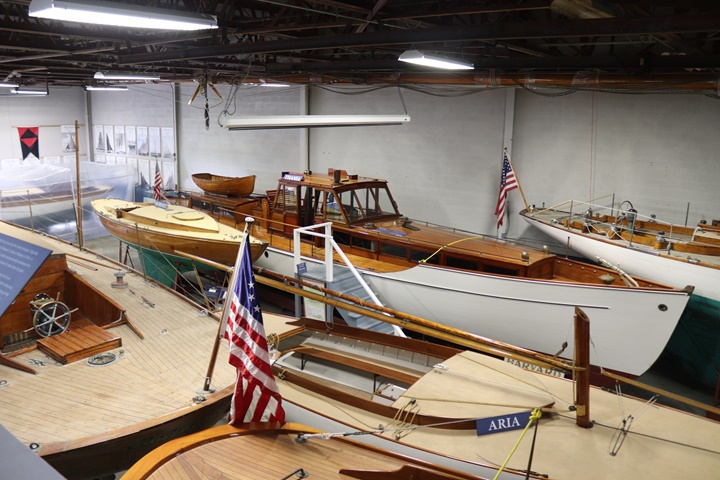
Author's photo.

The "Thania" was built in 1905 and was a
movie prop for the "Great Gatsby." It was donated in 1971, which
prompted the establishment of the Herreshoff Marine Museum. The
craftsmanship of the all-wooden vessel is superb. Very cool!!!
Author's photo.

Author's photo.

Author's photo.

Author's photo.

Author's photo.
|



























































